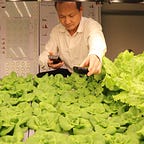Misunderstandings and tips on spectral reasearch of red to blue ratio of green house supplemental lighting
Matters needing attention and misunderstandings in the spectral research of red-blue ratio Supplemental Greenhouse Lighting
Let’s talk about the conclusion first: It should be more accurate to use the ratio of the blue wavelength PPFD of the plant canopy to the PPFD of the red wavelength as the ratio of red to blue.
Recently, a client discussed with me: which kind of red-blue ratio plant fill light is more suitable for crop growth. During the communication process, we found a lot of matters needing attention or misunderstandings in the research of red-blue ratio spectrum.
1, Did not choose the wavelength of the Horticulture LED
Blue LEDs of different wavelengths are almost indistinguishable to the naked eye
The peak wavelength of blue light at 450nm has a high photosynthetic absorption rate. The new research may be better at 435nm. If the 465nm blue LED is used for the spectral test of the plant grow lights the experimental effect can be imagined, and it will not be very good.
The red light peak wavelength of the plant grow lights has a high photosynthetic absorption rate of 660nm. If you use a 625nm or 630nm peak, it is not a good choice.
Different wavelengths of red LED chip, carefully observed, can see the difference.
2, Precautions or misunderstandings about the spectral ratio of plant grow lights
Red to blue ratio LED 1:1 (photosynthetic photon flux 1.6:1)
The spectral ratio in this picture is 1.5:1. It is actually composed of 1 red light and 1 blue light, that is, 1:1. 1.5:1 refers to the power or optical radiation flux, but the light of this spectrum is The ratio of radiant flux is 1.65:1, (51umol/S: 31umol/S)
Is it okay to use the ratio of photosynthetically active radiant flux as the benchmark for describing the ratio of red to blue? The answer is, not accurate.
The luminous angle of LED lamp beads, the arrangement and distribution of LEDs, and the design of secondary optics may all affect the actual proportion of light reaching the plant canopy.
Therefore, the ratio of red to blue may be different for different manufacturers; my red to blue ratio of 3:1, 5:1, 9:1 may be different from yours of 3:1, 5:1, 9:1.
Supplemental Greenhouse Lighting’s spectral research, the best way is:
Using a separate blue light channel, a separate red light channel, so that the spectrum can be adjusted to actually measure the photosynthetic photon density PPFD of each light reaching the plant canopy.
For example, using the TP50 dual-channel adjustable spectrum plant light, a light fixture can adjust the spectral ratio from 1:1 to 9:1. Do better spectral research on Greenhouse Supplemental grow lights.
